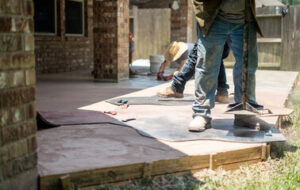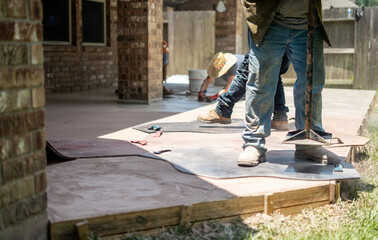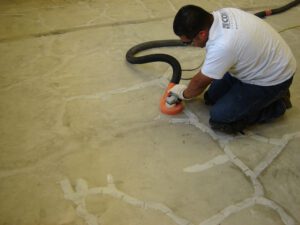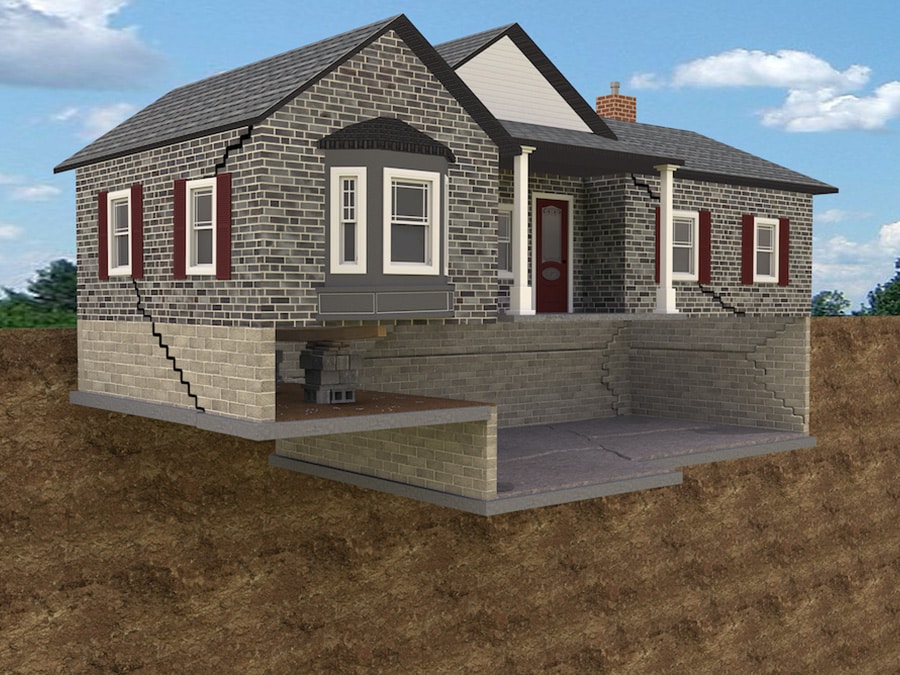Stamped Concrete Charles Town WV is a popular new technique that allows you to imitate the look of almost any type of material, including stone, tile, wood, or brick. It’s also significantly cheaper than organic materials like flagstone or slate.
 The coloring process usually involves powder or liquid pigments added to the concrete before stamping. A release agent is also used, which prevents the concrete from sticking to the mats.
The coloring process usually involves powder or liquid pigments added to the concrete before stamping. A release agent is also used, which prevents the concrete from sticking to the mats.
Concrete is one of the most affordable building materials available. Its durability and ease of use make it ideal for paving applications like driveways, patios, pool decks and other outdoor surfaces. Adding decorative coloring and patterning can take on the appearance of more expensive paving materials, such as natural stone, brick or pavers.
Unlike pavers or asphalt, which require regular resealing and maintenance, stamped concrete only needs resealing about once every two to three years. This is because concrete is not porous, so it does not absorb moisture or lose color the way paving materials do. In fact, it is possible to save even more on maintenance costs by installing a permeable concrete surface, which allows water to drain through the pores in the concrete and into the soil below.
Because of its affordability and low maintenance requirements, many homeowners choose to use stamped concrete in their landscaping projects. It is also an excellent option for businesses that want to upgrade their outdoor spaces without breaking the bank. It can be used to create a consistent look throughout an entire property or simply add a pop of color to an otherwise boring area.
With a wide range of color and pattern options, it is easy to find a design that complements the surrounding landscape or home. Choosing a style that matches the overall architectural design of your home will also help to increase its value if you decide to sell it in the future.
The cost of stamped concrete varies depending on the size of the project and complexity of the design. A basic pattern can be installed for about $8 per square foot, while more elaborate designs can cost up to $18 per square foot. A professional concrete contractor will be able to provide you with an accurate estimate once they have examined the site and discussed your preferences.
Another important factor to consider when calculating the cost of stamped concrete is the amount of labor involved in the installation process. Some patterns require multiple passes with the stamps to achieve the desired effect, which can lead to higher labor costs. In addition, if the concrete is not properly reinforced, it may crack over time. To prevent this from happening, the concrete contractor should install a vapor barrier and wire mesh or add a layer of reinforcement to the concrete before it is stamped.
Durability
Concrete is a durable material that resists wear and tear from heavy foot traffic and patio furniture. It doesn’t chip, crack or stain like pavers, and it can be stained a variety of colors to match your home and landscape.
The stamped concrete process uses rubber stamps or texturizing mats to imprint a pattern into wet concrete. This allows the concrete to mimic other materials, such as stone, wood or brick. The stamps can even be designed with a monogram, logo or other custom design. The result is a beautiful, customizable floor that looks like it was expensively installed but comes at a fraction of the cost.
Stamped concrete is an excellent option for patios, driveways, pool decks and walkways. It’s also suitable for outdoor fireplaces and other decorative landscaping features. It’s easy to clean, resistant to weeds and won’t lose its color over time. In fact, it holds up better than many other paving materials and requires less maintenance.
However, concrete is not without its drawbacks. It needs to be sealed on a regular basis to prevent damage from moisture, chemicals, moss and other contaminants. It is also prone to freeze-thaw cycles, which can cause it to crack over time. Additionally, it is not as permeable as other paving materials, which can lead to standing water and flooding.
Despite these drawbacks, stamped concrete is an affordable and practical choice for homeowners who want to enhance their outdoor spaces with high-end style and durability. It’s a great alternative to pavers and natural stones, and it can be used in place of traditional masonry for sidewalks and garden paths. Additionally, it adds value to your home and can help it stand out from other properties in the neighborhood. Whether you plan to sell your house in the future or are looking for ways to boost curb appeal, a concrete patio is an excellent investment. Contact a professional contractor to get started on your project today. They can help you choose the right color and style for your needs and give you an estimate for the cost of materials and labor.
Design Options
Unlike pavers, stamped concrete is poured on-site and can be designed to fit a wide range of aesthetics. In fact, many homeowners use the material to mimic pavers, stone or other natural materials in their outdoor spaces. Others use it to add a unique design element that sets their home apart from the rest of the neighborhood.
One of the biggest benefits of stamped concrete is its durability and affordability. It also requires less maintenance than other materials like asphalt and tile. Moreover, stamped concrete can be used for a variety of applications including driveways, patios and pool decks.
Before beginning a project with stamped concrete, it is important to determine the overall look you want. Some of the most popular choices are wood-like, stone and brick designs. Once the aesthetic has been determined, it is time to choose the right color and stamping tools. Before applying the concrete stamps, it is a good idea to apply a liquid release product, such as our Tru Impression Liquid Release, to ensure an even and consistent impression. When using skins, be sure to overlap slightly and step back often to examine the finished result. When the concrete is dry, it is a good idea to tamp thoroughly with a hand tamper to help the concrete adhere to the form.
Once the concrete has been stamped, it is a good idea to mist the surface regularly with water to prevent cracking. It is also a good idea to use a curing agent to speed up the process. There are a number of different curing agents on the market, so be sure to read the label carefully before choosing one.
Once the concrete has cured, it is ready to be enjoyed. A final brooming with a neutral detergent is a good way to remove any dirt and grime from the surface. A periodic washing may be necessary if moss or other plants begin to grow on the surface. If you maintain your stamped concrete properly, it can last for decades. In addition, a well-maintained patio or walkway can increase the value of your home and improve curb appeal.
Maintenance
Concrete is a durable material that can be used for many different purposes, including paving. When it’s stamped, the surface becomes more attractive and functional. The texture of the concrete can be made to look like a number of different materials, including stones, woods and tiles. In addition, the color of the concrete can be changed to match the design that is chosen. Stamped concrete is a great option for patios, driveways and pool decks. It can also be used in commercial buildings and other public spaces.
Stamped concrete is less expensive than pavers, cobblestones and bricks. It can also be installed faster than these other types of paving materials. This is because it is poured as a single slab, which means that the contractor doesn’t have to work around the individual components of the paving materials and place them one at a time. Another benefit of stamped concrete is that it requires less maintenance than these other paving materials. It only needs to be resealed every couple of years, which helps protect the concrete from moisture and weather elements.
However, if you want to keep your stamped concrete looking its best, it is important to regularly clean it with mild detergents or a pressure washer. Regular cleaning will help prevent the build-up of dirt and other debris, which can cause the concrete to lose its luster. If the concrete begins to show signs of deterioration, you should consider having it resealed.
Although stamped concrete is an affordable and low-maintenance option, it is not without its drawbacks. It is susceptible to cracking, which can be a problem if the area is heavily trafficked or if it’s exposed to freezing and thawing cycles. The cracks can be difficult to repair, and they may leave an unsightly pattern in the concrete. In addition, the concrete is also slippery when wet, which can be a safety hazard.
Another issue with stamped concrete is that it can fade over time, especially if it’s exposed to sunlight or chemicals. Fortunately, this can be avoided by using a high-quality sealer on the concrete after it is installed.




